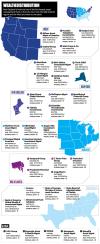Investors have been favoring index funds over their actively managed counterparts for years now, but active managers are seeing opportunities as markets shudder on news of China’s economic slowdown, doubts about Greece’s future in the euro zone and other concerns. While it’s safe to say that no one in asset management wants a market meltdown, managers are clearly itching to prove they can protect investors from the full brunt of any damage and once again outpace their benchmarks.
And investors appear willing to let them. Total assets of the firms in the II300, Institutional Investor’s annual ranking of America’s largest asset managers, rose nearly 7 percent year-over-year in 2014, from $42.3 trillion to $45.2 trillion.
More than 10 percent of that total is managed by New York–based BlackRock, which holds the top spot on this roster for a sixth year running. Vanguard Group — a clear beneficiary of the trend toward index investing, thanks largely to its exchange-traded and target-date funds — climbs one level to second place, with $2.71 trillion. The Malvern, Pennsylvania–based mutual fund giant’s increase of nearly $419 billion makes it the biggest gainer in dollar terms. (New York’s TIAA-CREF, which leaps from No. 20 to No. 15, is the year’s biggest gainer in percentage terms; its AUM total surged nearly 48 percent, to $816 billion.)
Vanguard’s ascension bumps Boston-based State Street Global Advisors, with $2.45 trillion, down a notch to third place. State Street’s crosstown rival, Fidelity Investments, rises one rung to No. 4, with $2 trillion. It displaces Allianz Asset Management of America, which slips one spot largely owing to losses at its Newport Beach, California-based subsidiary Pacific Investment Management Co. PIMCO’s assets dropped from $1.9 trillion to $1.7 trillion after famed bond manager Bill Gross departed for Janus Capital Management last fall.
To view the full list, click on America’s Top 300 Money Managers in the navigation table at right. Subscribers can access additional data, including regional rankings and details on the firms’ portfolio mixes.
Stephen Potter, president of Northern Trust Asset Management in Chicago, says “engineered equity” helps drive growth at the firm, which jumps from No. 13 to No. 11 after its AUM total increased by $50 billion, to $934 billion. “Engineered equity is more fulsome than smart beta,” he says. “We use factor models rather than just focusing on the benchmark.”

Share this Image on Your Site
Investors are increasingly investing in smart beta, which mixes active and passive strategies and often can provide systematic exposure to factors such as quality and low volatility. In the past they might have invested along the lines of style boxes, such as small-cap growth. Now they’re refining that by thinking more about risk. Potter says his firm is continuing to conduct research on factors and monitor them through market cycles. “There is no question that the commercialization of these products has a lot of room to run,” he adds.
Legg Mason, which has seven affiliate managers, also has its eye on smart-beta products. “Institutions are becoming more aware of the embedded bias in market-cap-weighted indexes,” observes Thomas Hoops, head of business development at the Baltimore-based firm, which slips from No. 17 to No. 18 even though its AUM total rose by $30 billion, to $709 billion: “There’s an interesting debate going on about what beta really is. It’s not just the S&P 500.”
Eric Colson, CEO of this year’s No. 61 firm, Milwaukee’s Artisan Partners (with AUM of $108 billion), believes that active management “is about products that are difficult to replicate with passive exposure.” If an investment can simply fit into a style box or category, an index fund might be able to compete; he wants Artisan’s offerings to be different. The firm just launched the Artisan Developing World Fund, which seeks to capitalize on growth opportunities but is not pegged to the MSCI Emerging Markets Index. It also boasts Mark Yockey, a renowned portfolio manager of global equity, who manages products that are concentrated and vary their exposure around the world.
“If passive is on one side and pure alpha is on the other, there is just too much in the middle,” says Colson. “If you’re an active manager, you have to increase your degrees of freedom so you can differentiate your investment exposure relative to an index.”
Lisa Jones, CEO of the U.S. division of No. 81, Italy’s Pioneer Investments, agrees that active managers can fight back against index funds by building flexibility into their products. “If you can smooth out volatility of returns and damp the drawdown, then you can compete alongside passive,” she maintains. Pioneer’s $6.5 billion concentrated equity strategy, which invests in 35 to 40 stocks and has delivered upside while protecting investors on the downside, is one example. The strategy has contributed to the firm’s growth this year, she says.
Jones explains that in the past managers could defend underperformance relative to a benchmark based on whether their style was in or out of favor. “As long as the underperformance was consistent, you got a hall pass,” she explains.
That’s changed with the growth of passive investing; institutional clients now expect managers to outperform in all market environments. “Clients look at managers who are truly making active bets in the portfolio, who have high conviction and a limited number of portfolio holdings,” Jones reports.
J.P. Morgan Asset Management, which remains at No. 6 on the II300, with $1.7 trillion, has built out teams around pension and insurance advisory in the U.S. and Europe, as well as market insight programs run by David Kelly, chief global strategist. The firm provides guidance to advisers on portfolio construction and asset allocation, such as how to use alternatives and get better diversification in fixed income.
George Gatch, global head of investment management clients, says half of the $55 billion that J.P. Morgan attracted in new global assets went into multiasset strategies, which include target-date funds, custom glide path funds, mandates for pensions and insurance companies, and alternatives. “Clients want more holistic advice, and we’re building that out,” he says. “The conversations that we’re having start broadly, then end with a solution around liability-driven investments or a strategic partnership with a defined benefit plan where we get a vertical slice of their portfolio. It’s a fundamental shift.”
To better compete against index funds, active managers need to protect their talent and ability to generate great returns. Although it’s not always fun to shut off a popular offering, closing funds is one of the best ways to protect a manager’s alpha generator. MFS Investment Management, which drops from No. 23 to No. 24 on this year’s roster, has closed 12 institutional strategies, from emerging-markets debt and international small-cap equity to global equity. “We need to restrict capacity to protect clients,” contends Michael Roberge, co-CEO and chief investment officer of the Boston-based firm, with AUM of $430 billion. “The bigger funds get, the more they drift and the more effect that has on performance.”
Visit Julie Segal’s blog and follow her on Twitter at @julie_segal.







